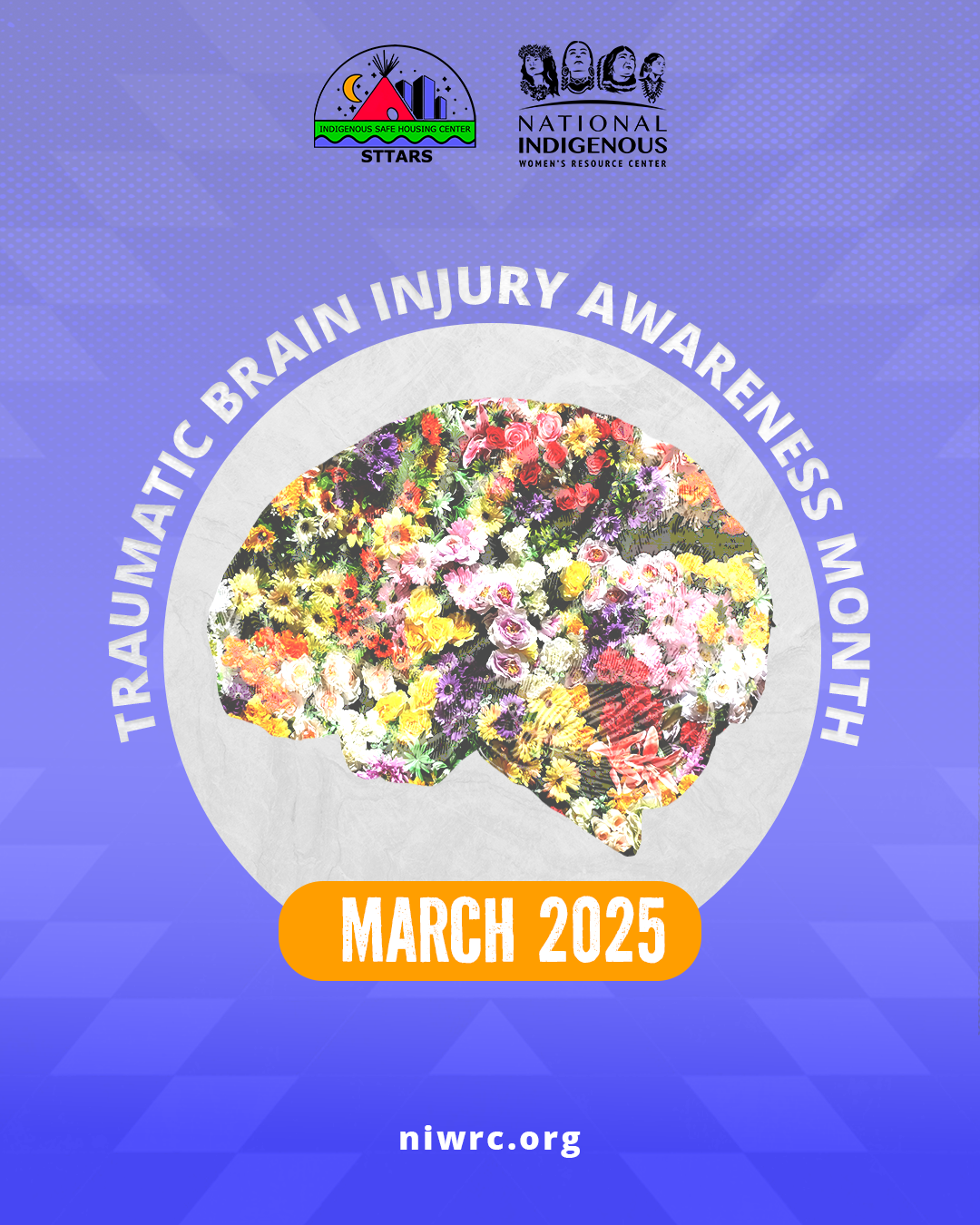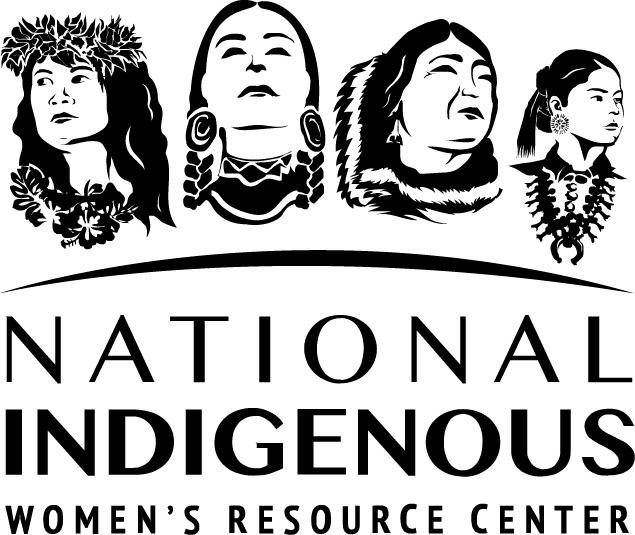March is Traumatic Brain Injury Awareness Month

The National Indigenous Women’s Resource Center (NIWRC) and STTARS Indigenous Safe Housing Center recognize March as Traumatic Brain Injury (TBI) Awareness Month. While TBIs are often associated with combat veterans, athletes, and other high-risk professions, research shows that women who experience TBIs due to domestic violence outnumber these groups by 11 to 12 times. Yet, TBIs in survivors of domestic violence often go unrecognized and untreated, creating a critical gap in education and awareness among health professionals, the criminal justice system, and even domestic violence advocates.
For Native women, the risk is even greater. High rates of domestic violence, strangulation, and physical assault in Tribal communities mean that many survivors suffer head trauma that often goes undiagnosed and untreated. The consequences are severe, leading to long-term health complications, housing instability, and significant barriers to healing and recovery. Throughout March, we invite you to join us in raising awareness about TBI in survivors of domestic violence. By expanding education, advocating for better screening and support, and sharing resources, we can work toward a future where all survivors receive the care and justice they deserve.
What is a Traumatic Brain Injury?
A Traumatic Brain Injury (TBI) is defined as damage to the brain caused by physical trauma resulting from incidents such as motor vehicle accidents, sporting events, falls, and physical assaults. A TBI is caused by an external force that is not present at birth or due to degeneration. This includes blows to the head, shaking of the brain, loss of oxygen (anoxia), colliding with a stationary object, and exposure to blasts. In the context of domestic violence, abusive partners often target a victim’s head, neck (including strangulation), and face, which can result in traumatic brain injuries.
In one study, 30% of domestic violence survivors reported a loss of consciousness at least once, and 67% reported ongoing issues that could be related to head injuries.[1]
The Link Between Domestic Violence and TBI
While TBI is more commonly recognized in other contexts, the connection between domestic violence (DV)/intimate partner violence (IPV) and TBI remains underreported in data and statistics. Domestic violence survivors often sustain TBIs from:
- Blows to the head (with fists, objects, or against surfaces)
- Strangulation, which cuts off oxygen to the brain (leading to anoxic injuries)
- Violent shaking (resulting in concussions)
- Falls or being thrown against walls or floors
Key Statistics
- Over 75% of domestic violence survivors sustain at least one TBI, with many going undiagnosed and untreated.[2]
- 84.3% of Native women experience violence in their lifetime, and 56.1% experience physical intimate partner violence.[3]
- The head, face, and neck are the most commonly injured areas in domestic violence incidents, leading to potential TBIs.[4]
- Without proper screening, Native survivors of domestic violence who experience TBI are often misdiagnosed with PTSD, depression, or anxiety, preventing them from receiving the appropriate care.[5]
TBI, Domestic Violence, and Housing Insecurity
Survivors living with undiagnosed TBIs face challenges that extend beyond physical health, affecting nearly every aspect of their lives:
- Memory loss, confusion, and difficulty concentrating
- Impaired decision-making, mood changes, and chronic fatigue
- Difficulties in maintaining housing, employment, and financial stability
In fact, 50% of individuals experiencing homelessness report that domestic violence was the primary cause of their housing instability, and more than half of those experiencing homelessness have a history of traumatic brain injury.[6] For survivors living in Tribal communities, these challenges are exacerbated by barriers to healthcare, limited shelter options, and a lack of services.
NIWRC Resources
By increasing awareness, expanding access to care, and advocating for change, we can help Native survivors reclaim their safety, dignity, and healing.
-
Special Collection: Intimate Partner Violence Intersections With Traumatic Brain Injury, Trauma, Mental Health, and Substance Use
The impact of severe physical violence, particularly against women, is fairly well-known. More has become known about traumatic brain injury, the neurobiology of trauma, mental health impacts, and substance use in the context of IPV. Included in this Collection are a number of organizations doing exceptional work in these various fields. -
STTARS Hosts: Hidden in Plain Sight: The Intersection of Brain Injury, Strangulation, Gender-Based Violence, Housing Insecurity, and Homelessness
Originally aired on March 13, 2024
Domestic violence often targets the head, neck, and face, leading to brain injuries. This webinar focuses on brain injuries resulting from violence, and offers practical tools for addressing this issue. -
Traumatic Brain Injury and DV-What are the connections?
Learn about the links between domestic violence and traumatic brain injuries (TBI), and how these injuries impact survivors’ ability to access services and resources. - Traumatic Brain Injury and Battering Booklet from the NIWRC Resource Library
A helpful resource that explores the connection between TBI and domestic violence, providing important insights for survivors and professionals alike.
Resources for Survivors and Advocates
General Resources:
- Washington State Department of Social and Health Services
- Brain Injury Association of America
The 2021-2023 campaign theme: More Than My Brain Injury. - Pink Concussions – Female Brain Injury from Sports, Violence, Military Service
Also includes a Partner-Inflicted Brain Injury Task Force. - Traumatic Brain Injury as a Result of Domestic Violence: Information, Screening, and Model Practices
From the Pennsylvania Coalition Against Domestic Violence. - The Center on Partner-Inflicted Brain Injury – Ohio Domestic Violence Network
- Brain/Head Injury, Strangulation - Information for Survivors
- Partner-Inflicted Brain Injury: Promising Practices for Domestic Violence Programs
Justice Clearinghouse:
Access various materials, technical assistance, and trainings, including:
- Invisible Epidemic: The Intersection of Traumatic Brain Injury, Strangulation, and Domestic Violence (Part 1)
- Invisible Epidemic: Addressing Traumatic Brain Injury, Strangulation, and Domestic Violence (Part 2)
- Violence Against Women and Acquired Brain Injury
- When Home Isn’t Safe: Domestic Violence and Brain Injury in the Era of COVID-19
For More Information:
- VAWnet: Understanding the Intersections of Traumatic Brain Injury and Domestic Violence
Includes general information, screening tools, training materials, and accommodations for survivors.
Resources for Survivors of Domestic Violence & TBI
For immediate support, these hotlines and resources are available:
-
StrongHearts Native Helpline: A confidential, anonymous helpline offering support for Native survivors of domestic violence and dating violence.
Available 24/7 at 1-844-7NATIVE (1-844-762-8483) -
The National Domestic Violence Hotline: Available 24/7 to offer support, safety planning, resources, and information.
Call 1-800-799-7233 or text "START" to 88788
- Campbell, J.C., Webster, D., & Glass, N. (2008). The Danger Assessment: Validation of a Risk Assessment Instrument for Intimate Partner Violence. Journal of Interpersonal Violence, 23(1), 34-50.
- Stark, E. (2009). Coercive Control: How Men Entrap Women in Personal Life. Oxford University Press.
- Rosay, A.B. (2016). Violence Against American Indian and Alaska Native Women and Men: 2010 Findings From the National Intimate Partner and Sexual Violence Survey. National Institute of Justice.
- National Institute of Justice. (2017). Intimate Partner Violence and the Risk of TBI.
- McCauley, J., et al. (2012). The Intersection of Intimate Partner Violence and Mental Health Disorders in Native American Women. Journal of American Indian and Alaska Native Mental Health Research, 19(1), 52-67.
- National Alliance to End Homelessness. (2021). Domestic Violence and Homelessness.





